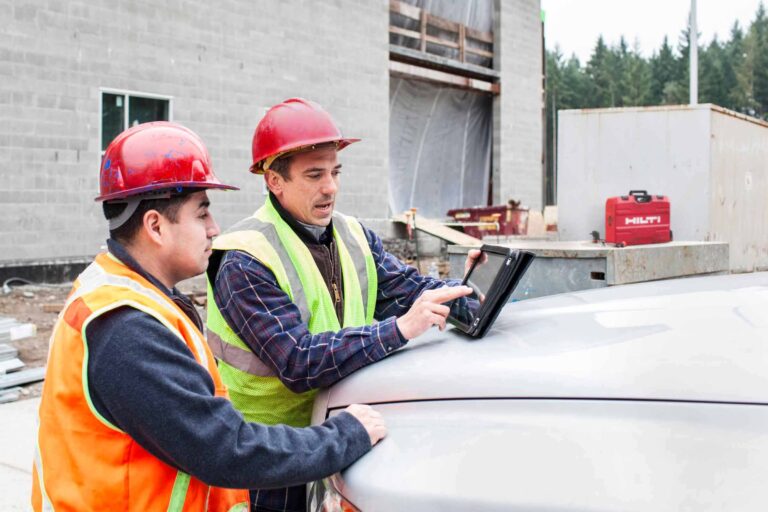
The construction industry has long reflected societal progress, from grand monuments of the past to sleek modern skyscrapers. Today, it stands at another key inflection point, driven by the rapid emergence of the Internet of Things (IoT). Once seen as futuristic, IoT is now reshaping how projects are managed and executed, using networks of connected devices to exchange data in real time. This blog explores how IoT is transforming construction management, what benefits it offers, the challenges ahead, and why staying current with this technology is crucial for anyone in the industry.
A Brief Overview of IoT in Construction
IoT can be defined as a network of devices equipped with sensors, software, and connectivity features that allow them to collect and exchange data. Within the construction sector, these devices can range from smart tools monitoring usage to heavy machinery analyzing performance in real time. Traditional methods of supervision and reporting often rely on manual data entry, which is both time-consuming and prone to human error. By contrast, IoT solutions offer instant, data-rich insights that streamline processes and significantly reduce risk.
Over the past decade, the drop in sensor costs and widespread availability of cloud computing have made IoT more accessible to construction companies of all sizes. Automated monitoring and real-time reporting can eliminate many of the inefficiencies associated with paper-based processes, allowing project managers and engineers to make informed decisions backed by accurate, up-to-the-minute data.
Driving Factors Behind IoT Adoption
One of the biggest factors fueling IoT’s rise in construction is the constant pressure to save costs and improve safety. Construction projects, with their multiple subcontractors, stringent deadlines, and reliance on heavy machinery, are notorious for being hard to manage using traditional oversight. IoT systems address these challenges by automatically collecting and sharing data through sensors on machinery, tools, and even building materials, ensuring a steady flow of information that helps avoid delays and boost collaboration.
Connectivity and cloud services are also crucial to IoT’s growing popularity. In the not-too-distant past, project data was logged at the end of the day or retrieved by physically gathering sensors for later analysis. Today, high-speed mobile networks and cloud platforms enable immediate data transfer, accessible to managers or stakeholders anywhere in the world. Moreover, modern analytics tools can process incoming data streams, offering predictive insights such as equipment maintenance needs or ideal workflows.
Applications of IoT on the Job Site
The spectrum of IoT applications on construction sites is extensive. Wearable devices such as smart helmets or safety vests can track worker location, heart rate, and temperature, providing real-time alerts when a worker is in a hazardous area or shows signs of distress. This proactive approach is invaluable in mitigating potential accidents before they escalate.
Asset tracking through RFID or GPS tags is another widespread application. Construction sites are large and often chaotic, and losing track of equipment or materials can cause frustrating delays. By automating the location process, IoT ensures managers know precisely where critical tools are, leading to more efficient resource allocation. Environmental monitoring is yet another critical use case, where smart sensors measure temperature, humidity, and air quality. Keeping materials in their required conditions helps preserve quality, and real-time environmental data can inform decisions on how to store or handle sensitive items.
Site security is another area where IoT is making a difference. Construction sites often face risks like theft, vandalism, or unauthorized access. IoT-enabled surveillance cameras, motion detectors, and smart locks provide centralized real-time monitoring, alerting site managers when suspicious activity occurs. This level of oversight vastly improves security while reducing labor costs for on-site guards.
Enhancing Safety and Efficiency through IoT
Safety remains a key driver of IoT implementation in construction. With workers operating at heights or near heavy machinery, accidents can happen in seconds. Wearables that track vital signs can detect early signs of heat exhaustion or stress, sending alerts to both the worker and supervisors. Location-based alerts can also prevent workers from entering restricted or unsafe zones. These timely warnings have already been credited with preventing accidents on some high-risk projects.
Efficiency also gets a considerable boost through IoT. Predictive maintenance is a prime example: sensors on machinery monitor temperature, vibration levels, and usage hours to anticipate a possible breakdown. By scheduling maintenance at the first sign of trouble, downtime is minimized, ultimately saving both time and money. The ability to track real-time asset locations and environmental conditions further optimizes workflow. If materials are delayed or a particular area is over capacity, managers can quickly rearrange schedules to avoid costly holdups.
Cost Savings and ROI
A common question among construction firms considering IoT is whether the return on investment justifies the upfront costs. In most cases, the answer is yes. By automating asset tracking and environmental monitoring, IoT helps reduce material waste. Accurate data on inventory and usage makes it easier to forecast requirements, thereby avoiding over-ordering or misplacing critical components.
Predictive maintenance of heavy machinery delivers substantial cost reductions by preventing unexpected breakdowns and elongating the lifespan of equipment. Though the initial expenses for sensors and cloud platforms may be considerable, these costs have dropped significantly in recent years. Many vendors offer subscription-based or pay-as-you-go models that lessen the financial barrier to entry. Moreover, IoT solutions often come with built-in analytics tools that highlight further efficiencies, adding extra value over time.
Companies can also save on labor costs. Tasks that once required manual logging, searching for tools, or double-checking inventories are now handled automatically by connected systems. Still, to maximize these benefits, organizations must allocate resources to train the workforce on how to interpret and act on the information generated by IoT platforms.

Challenges and Considerations
Despite IoT’s advantages, some challenges must be addressed. Data security is at the forefront. As soon as a device becomes internet-connected, it becomes a potential entry point for cyberattacks. Construction firms holding sensitive project data must therefore invest in encrypted communications, strong passwords, and routine software updates.
Integrating various IoT devices and platforms is another major hurdle. Construction often involves multiple subcontractors, each using different systems, which can create data silos. Standardizing platforms and adopting open APIs can minimize integration problems, ensuring data flows seamlessly. Another concern is workforce acceptance. Workers may be wary of new technology or resist changes to their daily routines. Clear communication and thorough training are essential to ease this transition, emphasizing improvements in safety and day-to-day work.
Finally, the sheer volume of data generated by IoT devices can lead to information overload. To avoid drowning in data, companies should focus on the metrics that truly matter, using analytics tools to sort and interpret the incoming information. Identifying relevant key performance indicators (KPIs) helps highlight actionable insights rather than bury managers in meaningless statistics.
Intersections with Other Emerging Technologies
IoT’s rise in construction is closely linked with other digital innovations. Building Information Modeling (BIM) is a standout example, providing detailed virtual representations of buildings and their components. When BIM integrates with IoT data, project teams can see in real time how actual conditions match the digital model, allowing for immediate adjustments if something deviates from plan.
Augmented Reality (AR) and Virtual Reality (VR) are also enhanced by IoT. An AR headset on-site could display machine performance or structural details directly over the user’s field of view, with the data fed from IoT sensors. Similarly, drones equipped with sensors can send site-mapping data to VR environments, offering immersive progress updates. Blockchain technology, meanwhile, can store sensor data or equipment logs on an immutable ledger, ensuring transparency for complex projects that require stringent compliance.
As 5G and other high-speed networks become more common, these convergences will likely accelerate. Faster connectivity enables real-time data streaming with minimal latency, supporting advanced analytics powered by AI and machine learning. This not only boosts productivity but also opens the door to truly connected “smart” construction sites where machines and systems work in harmony.
Future Outlook of IoT in Construction
The next few years promise even broader adoption of IoT in construction management. Sensor technology will continue to evolve, becoming cheaper, smaller, and more capable. IoT platforms will likely grow more modular, lowering the technical barriers and making it easier for smaller firms to adopt these tools. This democratization of advanced technology could level the playing field, allowing companies of all sizes to enjoy the benefits of real-time data and automation.
Meanwhile, environmental regulations and client expectations around sustainability continue to intensify. Here, IoT shines by providing precise measurements of energy usage, emissions, and waste generation. These metrics not only help builders comply with regulations but also enable them to find new efficiencies that reduce both costs and the project’s carbon footprint.
The convergence of IoT with artificial intelligence will also bring more predictive capabilities. Future sites could have autonomous robots that place or weld materials based on sensor input, adjusting on the fly to environmental variables. Drones might conduct daily aerial surveys, comparing construction progress against digital models to spot discrepancies. Combined with the analytics power of AI, site managers could receive recommendations for optimizing schedules, improving safety measures, or reducing resource consumption.
Why Staying Informed Matters
For anyone involved in construction—whether you’re a project manager, site supervisor, or engineer—keeping abreast of IoT trends is more than just staying current with technology. It’s about ensuring you remain competitive in a rapidly evolving market. Early adopters typically see better project outcomes, safer work environments, and stronger profit margins. Clients and investors also increasingly expect transparency and real-time data, which IoT delivers.
From a career perspective, skills in using or managing IoT technologies can open up new opportunities and differentiate professionals in a highly competitive industry. Workers trained to handle connected devices and interpret data become invaluable assets, while managers who excel at weaving real-time information into decision-making will set themselves apart.
Even broader industry trends point toward increased digitization, from prefabrication to modular construction. IoT is a foundational technology in these processes, tying together off-site factories, on-site assembly, and logistics in a single, connected chain. Embracing these developments now positions companies and workers to thrive in the data-driven environment that is quickly becoming the norm.
The rapid rise of IoT in construction management represents a fundamental shift in how buildings and infrastructure are planned, built, and maintained. By linking devices, tools, and people in networks that capture real-time data, IoT enables safer worksites, more efficient operations, and better overall project outcomes. Predictive maintenance helps avert expensive downtime, while automated tracking significantly reduces waste and confusion. Although challenges such as data security, system integration, and workforce acceptance remain, the benefits far outweigh the hurdles for firms that approach IoT with a well-thought-out strategy.
Moreover, IoT doesn’t operate in isolation. Its impact grows when paired with technologies like BIM, AR/VR, and AI-driven analytics, painting a picture of a connected future where data flows seamlessly, decisions are informed by live updates, and every resource is optimized for best results. Staying informed about these developments is increasingly important for industry professionals, investors, and stakeholders alike. As construction continues to evolve into a data-centric field, those who embrace IoT will help shape safer, more sustainable, and more efficient building practices for years to come.




